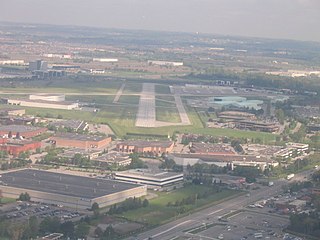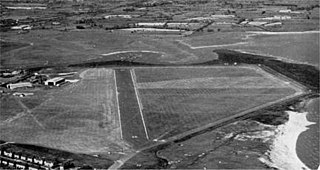Barker Field was one of several airfields in the Yorkdale area of Toronto, Ontario, Canada.
Barker Field was one of several airfields in the Yorkdale area of Toronto, Ontario, Canada.
Opened in 1927, it was a civilian and privately owned airfield for the early era of flying in Canada and was named after William George Barker in 1931, a First World War fighter ace and Victoria Cross recipient. It remained in use until 1953. The area (northwest corner of Lawrence Avenue West and Dufferin Street bounded by Dufflaw and Orfus) has since been re-developed as a commercial site (auto dealership, gas station and other businesses).
The airfield used a rudimentary grass or dirt surface for aircraft to take off and land. Originally three runways in a triangular configuration and later two runways in a T shape.
In 1931 Canadian Colonial Airlines flew from Barker Field to Buffalo. [1]
From 1937 and through World War II Barkers Field was owned and operated by Cyril (Red) L Murray. He ran Murray Aeronautical Corp Limited from Barkers Field until he sold it in the late 1940s. Leavens Bros Air Services relocated to the aerodrome in 1937 building hangars and workshops for their use and remaining there until 1953. [1] From 1950 to 1954 it was home to Aero Activities Limited, a flying school operated by Marion Alice Orr. [2] After Orr sold Barker Field, the property eventually ceased to be an airfield (workshops and hangars removed) and developed into the current land use for commercial, warehouse and light industrial use in what is now Yorkdale-Glen Park.

Floyd Bennett Field is an airfield in the Marine Park neighborhood of southeast Brooklyn in New York City, along the shore of Jamaica Bay. The airport originally hosted commercial and general aviation traffic before being used as a naval air station. Bennett Field is currently part of the Gateway National Recreation Area's Jamaica Bay Unit, and is managed by the National Park Service (NPS). While no longer used as an operational commercial, military, or general aviation airfield, a section is still used as a helicopter base by the New York City Police Department (NYPD), and one runway is reserved for hobbyists flying radio-controlled aircraft.

Buttonville Municipal Airport or Toronto/Buttonville Municipal Airport is a medium-sized airport in the neighbourhood of Buttonville in Markham, Ontario, Canada, 29 km (18 mi) north of Toronto. It is operated by Torontair. Due to its proximity to Toronto's suburbs, there are several strict noise-reduction procedures for aircraft using the airport, which is open and staffed 24 hours a day, 365 days a year. In 2014, Buttonville was Canada's 20th busiest airport by aircraft movements. There is also a weather station located at the airport.

Ottawa/Rockcliffe Airport or Rockcliffe Airport, a former military base, is a non-towered airport located on the south shore of the Ottawa River, 4 nautical miles northeast of Downtown Ottawa, Ontario, Canada. The airport is the home of the Canada Aviation Museum, which owns the field, and is used and maintained by the Rockcliffe Flying Club.

Downsview Airport is located in the North York district of Toronto, Ontario, Canada. An air field, then air force base, it has been a testing facility for Bombardier Aerospace since 1994. Bombardier has sold the facility and manufacturing plant and its future is uncertain.

Maple Airport was a small airfield in the Township of Vaughan in York Region, Ontario, Canada that was open from 1955 until 1987. The airport, established by Marion Alice Orr, one of Canada's first women pilots, consisted of two runways in an X pattern; 3,700 feet (1,100 m) and 2,500 feet (760 m). The early runway were grass strip and paved over in 1960.
Marion AliceOrr, CM was a pioneering Canadian aviator who was the first woman to run a flying school. She served with the Air Transport Auxiliary during World War II and was awarded the Order of Canada in 1986.

Armour Heights Field was home to a Royal Flying Corps airfield in Toronto, Ontario, Canada during World War I, and was one of three in the area. Many RFC pilots trained in Canada due to space availability. The airfield was opened in July 1917, but closed in 1919 as the war had ended. It was later developed as a residential development and remains as such today.

Leaside Aerodrome was an airport in the Town of Leaside, Ontario. It opened in 1917 as a Royal Flying Corps airfield during the First World War.

Long Branch Aerodrome was an airfield located west of Toronto, Ontario and just east of Port Credit, now Mississauga, and was Canada's first aerodrome. The airport was opened by the Curtiss Flying School, part of the Curtiss Aeroplane and Motor Company, as a pilot training school in 1915. In 1917 the airport was run by the Royal Flying Corps (RFC), and then closed in 1919. It is recognized by the existence of Aviation Road in the Lakeview, Mississauga community and a historical plaque.

Plum Island Airport, in Newburyport, Massachusetts, is a privately owned, public-use airport owned by Historic New England and operated by Plum Island Aerodrome, Inc., a non-profit corporation. It has two runways, averages 54 flights per week, and has approximately 8 based aircraft.

Old Sarum Airfield is a grass strip airfield 2 nautical miles north-north-east of Salisbury, Wiltshire, England.

Heston Aerodrome was an airfield located to the west of London, England, operational between 1929 and 1947. It was situated on the border of the Heston and Cranford areas of Hounslow, Middlesex. In September 1938, the British Prime Minister, Neville Chamberlain, flew from Heston to Germany three times in two weeks for talks with Adolf Hitler, and returned to Heston from the Munich Conference with the paper referred to in his later "Peace for our time" speech from 10 Downing Street.

Daniel Field is a public use airport located one nautical mile (2 km) west of the central business district of Augusta, a city in Richmond County, Georgia, United States. It is owned by the City of Augusta and operated by the General Aviation Commission. This airport is included in the National Plan of Integrated Airport Systems for 2021–2025, which categorized it as a general aviation facility.

Kingston Airport, also known as Norman Rogers Airport, is a regional airport located 4.3 nautical miles west of the core of Kingston, Ontario, Canada.

De Lesseps Field was a small, but important airfield in early aviation in Toronto, Ontario, Canada.

Royal Air Force Pengam Moors or more simply RAF Pengham Moors is a former Royal Air Force station and maintenance unit (MU), located on the Pengam Moors area of Tremorfa, 2 miles south east of Cardiff city centre in Wales from June 1938 to January 1946. It was also known as RAF Cardiff)

Markham Airport or Toronto/Markham Airport is a private aerodrome operating 2.6 nautical miles north of Markham, Ontario, Canada near Toronto.

Oberwiesenfeld Army Airfield is a former military airfield, located in Munich, Bavaria, Germany.

Hybla Valley Airport was an airfield and flying business in the Hybla Valley area of Fairfax County, Virginia. It received Virginia's first official airport permit. The airport was used in World War II for pilot training, and was also the site of dirigible facilities.

Royal Canadian Air Force Station Dunnville was a Second World War British Commonwealth Air Training Plan (BCATP) station located near Dunnville, Ontario. The station was home to No. 6 Service Flying Training School and is usually known by that name. Service Flying Training schools trained pilots, either single engine or multi-engine, and 6 SFTS was a single engine school. After graduation the new pilots were assigned various duties, which might be overseas in the Royal Air Force or an RCAF squadron; or in Canada as instructors or staff pilots in the BCATP, or for duty in RCAF Home Defence squadrons.
Coordinates: 43°42′54″N079°27′22″W / 43.71500°N 79.45611°W